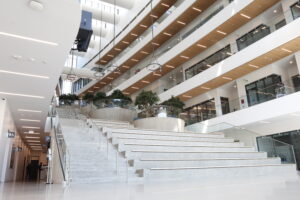By: Craig Allan, Peak Associate
On January 20, the Simon Fraser Student Society (SFSS) informed the student body the Student Union Building (SUB) will be closed from January 24 until further notice. After some debate, the SFSS agreed to re-open discussion around the building’s usage on February 18.
The closure is building-wide (though Blenz Coffee has remained open) for all but staff, who are given distancing regulations and are encouraged to work from home. This means SUB services — like the Health and Dental information office — will be only accessible online. The entire building will be off limits to the students who not only pay dues to the SFSS but financed the construction of the SUB. Citing concerns that SFU is not acting with the necessary caution to preserve student safety, the SFSS decided that closing the SUB was necessary to prevent the spread of COVID-19.
So their best course of action for this is to abandon their members and leave them with less space on campus? Less available study space means students will be forced into closer proximity with one another, increasing risk of disease transmission. The SUB is a building filled with seating and is one of the biggest indoor congregation areas at SFU Burnaby. To lock students out of the building is an abandonment of the students — the very members that the SFSS claims to care so much about.
Despite concerns about students’ lack of social distancing and mask-wearing habits, it remains true that the SUB is an optional space. No students were required to be there. Any non-employee uncomfortable with the proximity of those in the building was entirely able to find space elsewhere on campus to study or socialize. Though employee safety is paramount, there are less drastic methods of curtailing disease spread — like having employees work from home, or closing employee spaces to the public and implementing the same distancing procedures that are now in effect.
Closing the SUB weakens the SFSS’ statements that they represent student interests. The ongoing discussion by students upset about the building’s closure points to a disconnect with the SFSS’ actions, and the ideals of the student body. Though the SFSS surveyed students for their thoughts on a return to in-person education, there was no commentary solicited on the usage of the SUB. Student input on the closure of the SUB took the form of last-minute surveys by individual student unions, leaving little time for the feedback that should have surrounded such an impactful decision.
SFSS can say that they are closing the building because they care about the students, or because they don’t support the university’s decision to re-open so soon. But no matter their rationale, the results speak for themselves: SFU students now have less space for studying, services, and congregating. It is not by the decisions of the university, but of the Society whose main purpose is to advocate for students.














